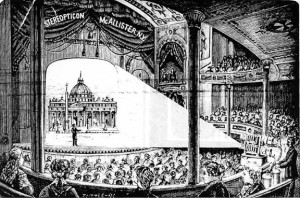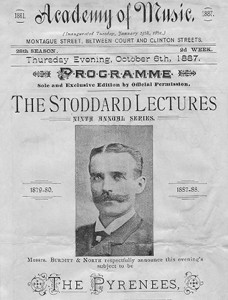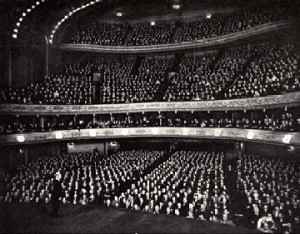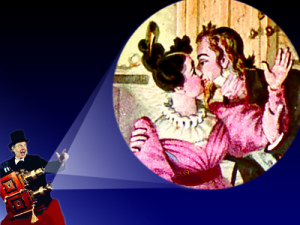
The thousands of American-made magic-lantern slides for sale on eBay every week—still surviving 100 years after their era—and the tens of thousands of slides for sale in the lantern catalogs a century ago, are both graphic evidence that there must have been a lot of people giving lantern shows. One study has estimated (very roughly) that in 1895 there were about 30,000–60,000 lantern performers in America, giving 75,000–150,000 performances a year.
The vast majority of these performances were not like the “magic lantern shows” that we usually think of today—a combination of story, song, and animated comedy. They were so-called “illustrated lectures,” that is, lectures on travel, science, religion, etc., “illustrated” with a lantern and slides that added a dramatic entertainment quality to the discourse, creating a kind of “edutainment” much like our modern Discovery Channel or Nova. Most of the performers were local people—teachers, ministers, fraternal leaders, and neighborhood amateurs—their audiences small to mid-sized. But there were also semi-professional and professional showmen, regional stars and national superstars who performed before very large audiences.

Two of the biggest American names were John L. Stoddard and his successor, Burton Holmes. Stoddard—the “Prince of Lecturers”—was one of the earliest showman, and in his time the most famous. He was a true magic-lantern star who had people standing in line all night for tickets to his shows, and who regularly sold out halls of two or three thousand seats, not just for a night, but for several weeks running. Stoddard’s specialty was the cultural travel lecture, and his most famous show was The Passion Play of Ober-Ammergau—about a pageant that had been given in Bavaria every ten years since 1633. When he retired after 17 years on the road, he was, in today’s dollars, a millionaire.
Stoddard anointed his successor, Burton Holmes, who followed closely in his footsteps. Unlike Stoddard, Holmes took many of his own photographs, some of which were stunning. As the times changed, so did Holmes, including movies in his “travelogues” when they became available. Towards the end of his life he was performing on television, and ended his career with a star on Hollywood Boulevard.

Emulating such superstars were the thousands and thousands of lesser showmen who gave their performances in small local halls, using slides that they had taken themselves, or bought or rented from catalogues. A single company’s catalogue might contain 50,000 images, providing a huge number of subjects to choose from. Travel lectures were the most popular, but science, nature, art and civic betterment were also important subjects. Variety shows, mixing stories, travel, and a few “comics for the children” were another popular format.

Many members of the Magic Lantern Society give shows, primarily shows that consist of the variety combination of stories, songs, and animated comedy that was also popular 100 years ago. These re-created shows range from entertainment that is “just for family,” to shows for local historical societies and schools, to the productions of The American Magic Lantern Theater, a professional company that performs nationally and internationally.
The large number of shows 100 years ago meant that there were millions of slides in circulation, and on any given week today, thousands can still be found on eBay, many of them in the $1–10 range. Just search “magic lantern” to get started giving your own shows!